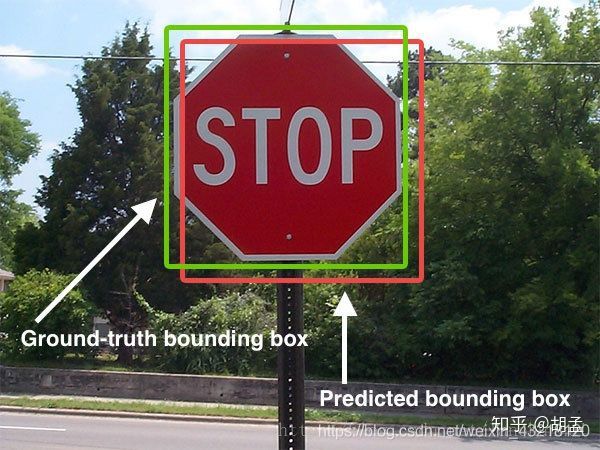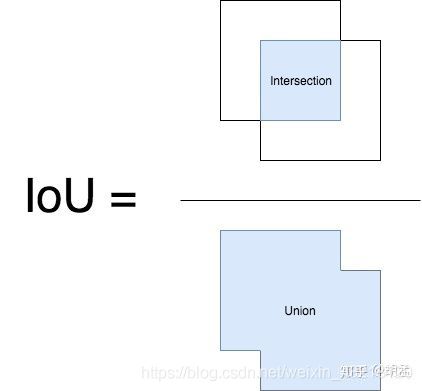计算机视觉基础之IoU和mIoU
IoU
IoU(Intersection over Union),又称重叠度/交并比。
1、NMS:当在图像中预测多个proposals、pred bboxes时,由于预测的结果间可能存在高冗余(即同一个目标可能被预测多个矩形框),因此可以过滤掉一些彼此间高重合度的结果;具体操作就是根据各个bbox的score降序排序,剔除与高score bbox有较高重合度的低score bbox,其中重合度的度量指标就是IoU
2、mAP:得到检测算法的预测结果后,需要对pred bbox与gt bbox一起评估检测算法的性能,涉及到的评估指标为mAP,那么当一个pres bbox与gt bbox的重合度较高(如IoU score >0.5),且分类结果也正确,就可以认为是该pred bbox预测正确,其中也涉及IoU的 概念。

绿框:gt bbox
红框: pred bbox

IoU = gt bbox、pred bbox交集的面积 / 二者并集的面积
# -*- coding: utf-8 -*-
#
# This is the python code for calculating bbox IoU,
# By running the script, we can get the IoU score between pred / gt bboxes
#
# copyright @ netease, AI group
from __future__ import print_function, absolute_import
import numpy as np
def get_IoU(pred_bbox, gt_bbox):
"""
return iou score between pred / gt bboxes
:param pred_bbox: predict bbox coordinate
:param gt_bbox: ground truth bbox coordinate
:return: iou score
"""
# bbox should be valid, actually we should add more judgements, just ignore here...
# assert ((abs(pred_bbox[2] - pred_bbox[0]) > 0) and
# (abs(pred_bbox[3] - pred_bbox[1]) > 0))
# assert ((abs(gt_bbox[2] - gt_bbox[0]) > 0) and
# (abs(gt_bbox[3] - gt_bbox[1]) > 0))
# -----0---- get coordinates of inters
ixmin = max(pred_bbox[0], gt_bbox[0])
iymin = max(pred_bbox[1], gt_bbox[1])
ixmax = min(pred_bbox[2], gt_bbox[2])
iymax = min(pred_bbox[3], gt_bbox[3])
iw = np.maximum(ixmax - ixmin + 1., 0.)
ih = np.maximum(iymax - iymin + 1., 0.)
# -----1----- intersection
inters = iw * ih
# -----2----- union, uni = S1 + S2 - inters
uni = ((pred_bbox[2] - pred_bbox[0] + 1.) * (pred_bbox[3] - pred_bbox[1] + 1.) +
(gt_bbox[2] - gt_bbox[0] + 1.) * (gt_bbox[3] - gt_bbox[1] + 1.) -
inters)
# -----3----- iou
overlaps = inters / uni
return overlaps
def get_max_IoU(pred_bboxes, gt_bbox):
"""
given 1 gt bbox, >1 pred bboxes, return max iou score for the given gt bbox and pred_bboxes
:param pred_bbox: predict bboxes coordinates, we need to find the max iou score with gt bbox for these pred bboxes
:param gt_bbox: ground truth bbox coordinate
:return: max iou score
"""
# bbox should be valid, actually we should add more judgements, just ignore here...
# assert ((abs(gt_bbox[2] - gt_bbox[0]) > 0) and
# (abs(gt_bbox[3] - gt_bbox[1]) > 0))
if pred_bboxes.shape[0] > 0:
# -----0---- get coordinates of inters, but with multiple predict bboxes
ixmin = np.maximum(pred_bboxes[:, 0], gt_bbox[0])
iymin = np.maximum(pred_bboxes[:, 1], gt_bbox[1])
ixmax = np.minimum(pred_bboxes[:, 2], gt_bbox[2])
iymax = np.minimum(pred_bboxes[:, 3], gt_bbox[3])
iw = np.maximum(ixmax - ixmin + 1., 0.)
ih = np.maximum(iymax - iymin + 1., 0.)
# -----1----- intersection
inters = iw * ih
# -----2----- union, uni = S1 + S2 - inters
uni = ((gt_bbox[2] - gt_bbox[0] + 1.) * (gt_bbox[3] - gt_bbox[1] + 1.) +
(pred_bboxes[:, 2] - pred_bboxes[:, 0] + 1.) * (pred_bboxes[:, 3] - pred_bboxes[:, 1] + 1.) -
inters)
# -----3----- iou, get max score and max iou index
overlaps = inters / uni
ovmax = np.max(overlaps)
jmax = np.argmax(overlaps)
return overlaps, ovmax, jmax
if __name__ == "__main__":
# test1
pred_bbox = np.array([50, 50, 90, 100]) # top-left: <50, 50>, bottom-down: <90, 100>, 转载至https://zhuanlan.zhihu.com/p/47189358
mIoU
Mean Intersection over Union(MIoU, 均交并比),为语义分割的标准度量。其计算两个几个的交集和并集之比,在语义分割问题中,这两个集合为真实值(ground truth)和预测值(predicted segmentation)。这个比例可以变形为TP(交集)比上TP、FP、FN之和(交集)。在每个类上计算IoU,然后取平均。
tf源码解析
第一步:计算混淆矩阵
# 主要代码
def confusion_matrix(labels, predictions, num_classes=None, dtype=dtypes.int32,
name=None, weights=None):
# 例子:labels = [0, 1, 2, 0, 3]
# predictions =[0, 1, 1, 3, 3]
if num_classes is None: # 不指定类别个数,就以labels或者predictions最大的指定,即4
num_classes = math_ops.maximum(math_ops.reduce_max(predictions),
math_ops.reduce_max(labels)) + 1
else:
num_classes_int64 = math_ops.cast(num_classes, dtypes.int64)
labels = control_flow_ops.with_dependencies(
[check_ops.assert_less(
labels, num_classes_int64, message='`labels` out of bound')],
labels)
predictions = control_flow_ops.with_dependencies(
[check_ops.assert_less(
predictions, num_classes_int64,
message='`predictions` out of bound')],
predictions)
if weights is not None:
predictions.get_shape().assert_is_compatible_with(weights.get_shape())
weights = math_ops.cast(weights, dtype)
shape = array_ops.stack([num_classes, num_classes])
indices = array_ops.stack([labels, predictions], axis=1)
# indices = [[0,0],[1,1],[2,1],[0,3],[3,3]]
values = (array_ops.ones_like(predictions, dtype)
if weights is None else weights)
# 对应位置的values,若不指定,则全为1
cm_sparse = sparse_tensor.SparseTensor(
indices=indices, values=values, dense_shape=math_ops.to_int64(shape))
# 稀疏张量,指定indices位置为指定value,其他位置为0
# 多次指定一个位置,value为多次相加的结果
zero_matrix = array_ops.zeros(math_ops.to_int32(shape), dtype)
return sparse_ops.sparse_add(zero_matrix, cm_sparse)
SparseTensor例子:
import tensorflow as tf
a = tf.SparseTensor(indices=[[0,0], [1,2], [0, 0]], values=[1, 1, 1], dense_shape=[3, 4])
zero_m = array_ops.zeros(math_ops.to_int32([3,4]),dtype=tf.int32)
r = sparse_ops.sparse_add(zero_m, a)
sess = tf.Session(config=tf.ConfigProto(device_count={'cpu':0}))
sess.run(r)
# array([[2, 0, 0, 0],
# [0, 0, 1, 0],
# [0, 0, 0, 0]], dtype=int32)
第二步:计算mIoU
def compute_mean_iou(total_cm, name):
"""Compute the mean intersection-over-union via the confusion matrix."""
sum_over_row = math_ops.to_float(math_ops.reduce_sum(total_cm, 0))
sum_over_col = math_ops.to_float(math_ops.reduce_sum(total_cm, 1))
cm_diag = math_ops.to_float(array_ops.diag_part(total_cm)) # 交集
denominator = sum_over_row + sum_over_col - cm_diag # 分母,即并集
# The mean is only computed over classes that appear in the
# label or prediction tensor. If the denominator is 0, we need to
# ignore the class.
num_valid_entries = math_ops.reduce_sum(
math_ops.cast(
math_ops.not_equal(denominator, 0), dtype=dtypes.float32)) # 类别个数
# If the value of the denominator is 0, set it to 1 to avoid
# zero division.
denominator = array_ops.where(
math_ops.greater(denominator, 0), denominator,
array_ops.ones_like(denominator))
iou = math_ops.div(cm_diag, denominator) # 各类IoU
# If the number of valid entries is 0 (no classes) we return 0.
result = array_ops.where(
math_ops.greater(num_valid_entries, 0),
math_ops.reduce_sum(iou, name=name) / num_valid_entries, 0) #mIoU
return result
通过tf.metrics.mean_iou的API可以得到mIoU,但并没有把各类IoU释放出来,为了计算各类IoU,可以修改上面的代码,获取IoU中间结果,也可以用weight的方式变相计算。
基本思路就是把只保留一类的IoU,其他类IoU置零,然后最后将mIoU * num_classes就可以了。
tp_position = tf.equal(tf.to_int32(labels), tf.to_int32(predictions))
label_0_weight = tf.where((tp_position & tf.not_equal(labels, 0)), tf.zeros_like(labels),
tf.ones_like(labels))
## 混淆矩阵对角线上只保留一类非0,其他类都置0
metric_map['IOU/class_0_iou'] = tf.metrics.mean_iou(
predictions, labels, dataset.num_classes, weights=label_0_weight)
## 结果是0类IoU/num_classes
pytorch源码解析:
class IOUMetric:
"""
Class to calculate mean-iou using fast_hist method
"""
def __init__(self, num_classes):
self.num_classes = num_classes
self.hist = np.zeros((num_classes, num_classes))
def _fast_hist(self, label_pred, label_true):
mask = (label_true >= 0) & (label_true < self.num_classes)
hist = np.bincount(
self.num_classes * label_true[mask].astype(int) +
label_pred[mask], minlength=self.num_classes ** 2).reshape(self.num_classes, self.num_classes)
return hist
def add_batch(self, predictions, gts):
for lp, lt in zip(predictions, gts):
self.hist += self._fast_hist(lp.flatten(), lt.flatten())
def evaluate(self):
acc = np.diag(self.hist).sum() / self.hist.sum()
acc_cls = np.diag(self.hist) / self.hist.sum(axis=1)
acc_cls = np.nanmean(acc_cls)
iu = np.diag(self.hist) / (self.hist.sum(axis=1) + self.hist.sum(axis=0) - np.diag(self.hist))
mean_iu = np.nanmean(iu)
freq = self.hist.sum(axis=1) / self.hist.sum()
fwavacc = (freq[freq > 0] * iu[freq > 0]).sum()
return acc, acc_cls, iu, mean_iu, fwavacc
pytorch简化版:
#RT:RightTop
#LB:LeftBottom
def IOU(rectangle A, rectangleB):
W = min(A.RT.x, B.RT.x) - max(A.LB.x, B.LB.x)
H = min(A.RT.y, B.RT.y) - max(A.LB.y, B.LB.y)
if W <= 0 or H <= 0:
return 0;
SA = (A.RT.x - A.LB.x) * (A.RT.y - A.LB.y)
SB = (B.RT.x - B.LB.x) * (B.RT.y - B.LB.y)
cross = W * H
return cross/(SA + SB - cross)